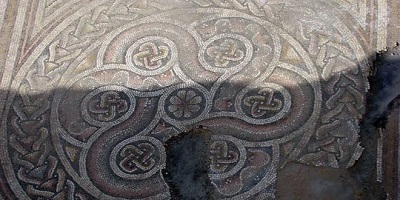DAMASCUS, (ST) – The National Archaeological Mission in Wadi Barada at al – Zabadani region found a mosaic plate of about 50 meters in size dates back to the 4th century AD.
The painting formed the floor of a large hall with a wide door composed of a wide entrance in the middle and two narrower side entrances. The painting includes artistic scenes and geometric, vegetal and symbolic motifs that were implemented with small pieces of stone with various colors and high-level technique. The painting indicates that the decoration dates back to the end of the Roman period and the beginning of the Byzantine era and refers to the rich of thisarchaeological site in architecture including palaces, temples, monasteries, churches and others.
“The importance of the painting comes from being the first of its kind in the area of Damascus and its countryside,”. The painting also indicates the importance of the archaeological site, which was the capital of a Kingdom known as Abilineh during the era of the Seleucid state in the three centuries BC and then was known in the name of Abila during the Roman and Byzantine eras,” said Dr. Mahmoud Hammoud, Director of the Archaeology of Damascus countryside .
Dr. Hammoud said: “This state was founded by the Al -Aitoryoun , an Arab tribe that inhabited the area of the mountains of eastern Lebanon and took from Anjar as headquarters and from Baalbek, a religious center. The influence of this state stretched from Hermon in the south to Qara town in the north. The intensity of archaeological sites that extend over three adjacent villages (Souk Wadi Barada, Barrhleya, and Kafr Al-Awamid)demonstrates the importance of this capital and the density of housing in it,”pointing out that a similar panel was found in the same location and moved to the National Museum in Damascus two years ago.
During the sixties of the last century,it was found in the site an altar of a temple with some forms were carved on it , including a picture representing the god of the Barada River in the Roman era, which was called Krisorwas, the name that was givento the river during that stage which means “The River of Gold” before the name of “Paradnees or Paradise”and it is believed that the current name was derived from it.
The site has been subjected to large operations of illegal excavations during the previous years, which led to the detection of hundreds of tombs and ancient graves and its contents were looted.
Sharif al -Khatib

